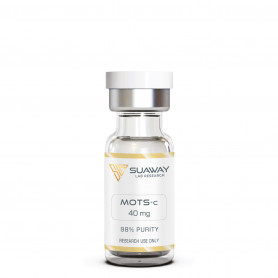Description
STRUCTURE
Sequence: H-Pro-Pro-Leu-Ser-Gln-Glu-Thr-Phe-Ser-Asp-Leu-Trp-Lys-Leu-Leu-Lys-Lys-Trp-Lys-Met-Arg-Arg-Asn-Gln-Phe-Trp-Val-Lys-Val-Gln-Arg-Gly-OH
Molecular Formula: C188H293N53O44S
Molecular Weight: 4029.2 g/mol
CAS Number: 1159861-00-3
Peptide Purity: Greater than 98%.
Other details: No TFA Salt, No Mannitol
Storage: Lyophilized peptide must be stored at -20°C and peptide solution at 4°C.
PNC-27 has low oral and excellent subcutaneous bioavailability.
DESCRITPION
A synthetic peptide called PNC-27 is intended to selectively target and kill cancer cells. It belongs to the PNC family of research proteins that adhere to abnormal (cancerous) cells and trigger cell necrosis in them while sparing normal, healthy cells from damage.
The PNC-27 peptide has a transmembrane-penetrating domain and an HDM-2 binding domain that binds to p53 residues 12-26. Because of the rupture of the cell membrane, known as membranolysis, the peptide can attach to and destroy cancer cells.
The PNC-27 peptide has been demonstrated to be very successful in specifically targeting a broad range of distinct types of cancer, including pancreatic cancer, breast cancer, leukemia, melanoma, and other cancer lines, via research and study on animal subjects.
Drs. Matthew Pincus and Joseph Michl of the SUNY Downstate Medical Center in New York initially proposed and developed PNC proteins in 2000. PNC-27 shows a surprising capacity to connect to cancer cells, causing them to perish, while leaving healthy cells unharmed.
The harmless cancer peptide PNC-27 solely kills cancer cells; it has no harmful side effects on any healthy cells. It does this by adhering to and rupturing the membranes of the particular cancer cells. The holes cause a fast implosion that quickly results in cell death because of the differential in osmotic pressure between the cancer cells' inside and outside.
PNC-27 can do this because of its affinity for the protein HDM-2. HDM-2 is present in the cell membranes of cancerous cells. The HDM-2 found in the membranes of malignant cells is promptly reached once the PNC-27 peptide is injected. By attaching to them, it causes "membranolysis," or the death of the cell membrane, by forming pores or holes in the cell membrane. This ultimately results in the cancer cell being destroyed.
Certain characteristics have been identified in favorable results when the PNC-27 peptide is delivered in animal trials. According to research, subjective pain levels often decrease after a week or so. By the third week, animal subjects often exhibit flu-like symptoms, which is probably a sign that their immune systems are reacting to the killing of cancer cells.
Levels of bilirubin and lactate dehydrogenase normally rise around 6 weeks. Successful study findings often show significant cancer destruction at roughly the 10-week point. The cancers are seen to soften and become more malleable at this point.
At this point, the cancer's size may have increased somewhat. However, this often results from inflammation brought on by an immunological reaction. After three months, scientists often see that the animal study participants have more energy and fewer cancer-related symptoms.
Animal studies have shown PNC-27's negative effects. They include included taste changes, watery eyes, dry skin, watery eyes, high blood pressure, headaches, backaches, nosebleeds, rectal bleeding, and excessive protein in the urine.
Notably, whereas untransformed or non-cancerous cells do not contain high quantities of HDM-2 in their membranes, cancer cells do. This enables the PNC-27 peptide to target the malignant cells while sparing the healthy tissue around them.
Amazingly, researchers found that when the cancer-killing peptide was given, it completely halted any cancer development for the two weeks after therapy as well as for two weeks afterward. In contrast to cancer development when a control peptide was present, this was followed by poor cancer growth that eventually reached a plateau at small cancer sizes.
A more recent study from 2014 that was published in the Annals of Clinical & Laboratory Science concluded that "the expression of HDM-2 in the plasma membrane of these cells is required for the anti-cancer peptide, PNC-27, to cause cancer cell necrosis of a weakly differentiated non-solid tissue murine leukemia cell line.
REFERENCES
K. Davitt et al., "The anti-cancer peptide, PNC-27, induces tumor cell necrosis of a poorly differentiated non-solid tissue human leukemia cell line that depends on expression of HDM-2 in the plasma membrane of these cells" [PubMed]
K.A. Sookraj et al., "The anti-cancer peptide, PNC-27, induces tumor cell lysis as the intact peptide" [PubMed]
E.S. Yazdi et al., "Ex vivo Efficacy of Anti-Cancer Drug PNC-27 in the Treatment of Patient-Derived Epithelial Ovarian Cancer" [PubMed]
Mi. Silberstein "Is PNC-27 and PNC-28 the best way to cure cancer?" [The Science Journal of the Lander College of Arts and Sciences]
P.M Aguon et al., "Experimental PNC-27 Therapy and Massive GI Hemorrhage: A Complication or Coincidence?" [AJG]
E. Sarafraz-Yazdi et al., "PNC-27, a Chimeric p53-Penetratin Peptide Binds to HDM-2 in a p53 Peptide-like Structure, Induces Selective Membrane-Pore Formation and Leads to Cancer Cell Lysis" [MDPI]
E. Sarafraz-Yazdi et al., "Anticancer peptide PNC-27 adopts an HDM-2-binding conformation and kills cancer cells by binding to HDM-2 in their membranes" [PNAS]
DISCLAIMER
This product is intendend for lab research and development use only. These studies are performed outside of the body. This product is not medicines or drugs and has not been approved by the FDA or EMA to prevent, treat or cure any medical condition, ailment or disease. Bodily introduction of any kind into humans or animals is strictly forbidden by law. This product should only be handled by licensed, qualified professionals.
All product information provided on this website is for informational and educational purposes only.












